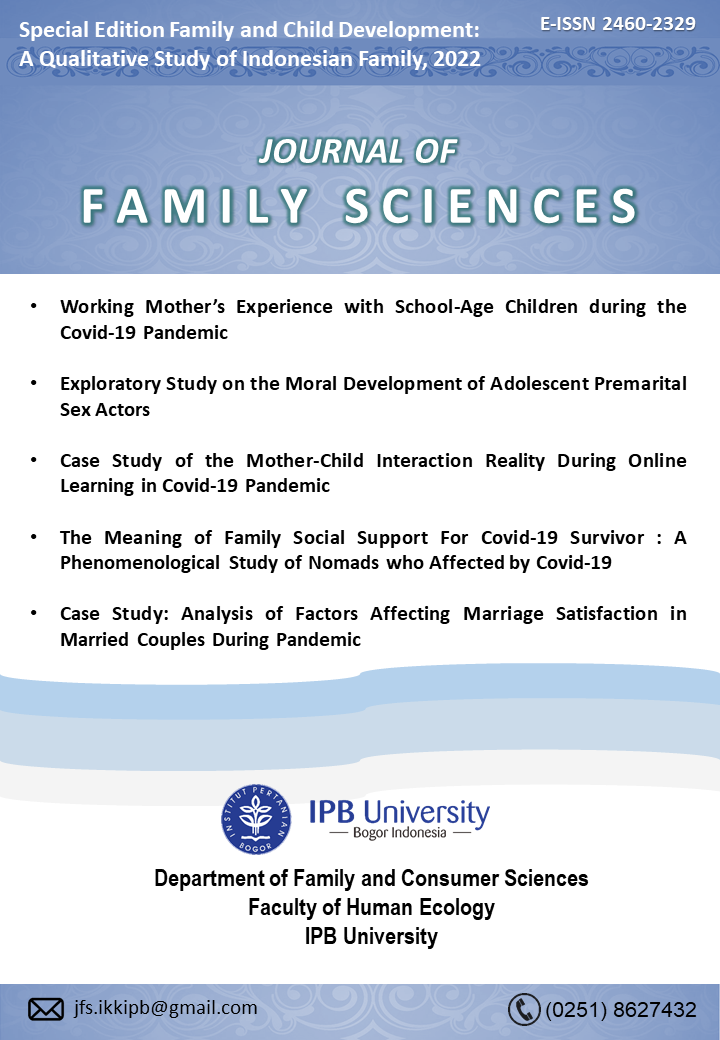Case Study of the Mother-Child Interaction Reality During Online Learning in Covid-19 Pandemic
Case Study of the Mother-Child Interaction Reality During Online Learning in Covid-19 Pandemic
Abstract
This study aims to see how mother-daughter interactions during the COVID-19 pandemic are based on the mother's perspective. The research design used a qualitative research design. Examples in this study are two mothers with children of primary school age and one mother with children of junior high school age. The research was conducted from 5 to 11 March 2021 in three places, namely Jakarta, Banten, and Bandung. The research method is a case study. The results showed that the interaction between mother and child involves two main concepts of acceptance and conflict. They listen with pride, express, take special time, say good things, praise, understand, and friendship between mother and child. Conflict resolution is designated in the category that can resolve conflicts and trigger conflicts. Categories that can resolve conflict include active listening, appreciation, rules, discipline, trust, and time together. In comparison, conflict triggers include conflict, openness, criticism, and position. Covid-19 causes children to experience dependence on maternal violence, stress on children, and indications of verbal abuse from mothers, to mothers who experience stress when accompanying children to learn to be brave.
Downloads
References
Afiatin, N. (2015). The effect of parental attention and student interest in learning on social science learning achievement (Pengaruh perhatian orang tua dan minat belajar siswa terhadap prestasi belajar ilmu pengetahuan sosial). Faktor: Jurnal Ilmiah Kependidikan, 2(1), 1–9. http://dx.doi.org/10.30998/fjik.v2i1.370
[APA] American Psychological Association. (2020). Stress in America 2020: Stress in the time of COVID-19 volume one [press release]. Retrieved from https://www.apa.org/news/press/releases/stress/2020/report
Cahyati, N., & Kusumah, R. (2020). The role of parents in implementing learning at home during the covid-19 pandemic (Peran orang tua dalam menerapkan pembelajaran di rumah saat pandemi covid-19). Jurnal Golden Age, 4(1), 4–6. https://doi.org/10.29408/jga.v4i01.2203
Creswell, J. W. (2009). Qualitative procedures. in research design: qualitative, quantitative, and mixed method approaches (3rd Edition ed.). New Jersey: SAGE Publications, Inc.
Creswell, J. W., & Poth, C. N. (2018). Qualitative Inquiry and Research Design Choosing Among Five Approaches (4th Edition ed.). California: SAGE Publishing.
Duckworth, A. L., & Seligman, M. E. P. (2005). Self-discipline outdoes IQ in predicting academic performance of adolescents. Psychological Science, 16(12), 939–944. https://doi.org/10.1111/j.1467-9280.2005.01641.x
Fitri, W. (2013). Women and disaster mitigation women saving effort in disaster managing based on gender. Jurnal Kajian Ilmiah Gender, 3(1), 13-25.https://doi.org/10.15548/jk.v3i1.66
Fraenkel, P., & Cho, W. L. (2020). Reaching up, down, in, and around: Couple and family coping during the coronavirus pandemic. Family Process, 59(3), 847–864.https://doi.org/10.1111/famp.12570
Gloria, J. T. (2021). Stress pada ibu terhadap pembelajaran daring selama Pandemi Covid-19. https://doi.org/https://doi.org/10.31219/osf.io/prbkd
Jaishy, R., & Pandey, A., K. (2020). Chapter 6: family dynamics during lockdown. Handbook of mental health issues during covid-19 pandemic. Hindu University, Varanasi.
Kerr, M., Stattin, H., & Trost, K. (1999). To know you is to trust you: Parents' trust is rooted in child disclosure of information. Journal of Adolescence, 22(6), 737–752. https://doi.org/10.1006/jado.1999.0266
Kucirkova, N., Messer, D., Sheehy, K., & Flewitt, R. (2013). Sharing personalized stories on iPads: A close look at one parent-child interaction. Literacy, 47(3), 115–122. https://doi.org/10.1111/lit.12003
Kumar, A., & Nayer, K. R. (2020). Covid-19 and its mental health consequences. Journal of Mental Health (Abingdon, England), 0(0), 1–2. https://doi.org/10.1080/09638237.2020.1757052
Kurniati, E., Kusumanita, D., Alfaeni, N., & Andriani, F. (2021). Analysis of the role of parents in accompanying children during the COVID-19 Pandemic (Analisis peran orang tua dalam mendampingi anak di masa pandemi covid-19). Jurnal Obsesi, 5(1), 241–256. https://doi.org/10.31004/obsesi.v5i1.541
Lange, A., Evers, A., Jansen, H., & Dolan, C. (2002). PACHIQ-R: The parent-child interaction questionnaire-revised. Family Process, 41(4), 709–722. https://doi.org/10.1111/j.1545-5300.2002.00709.x.
Muslim, M. (2020). Stress management during the covid-19 pandemic (Manajemen stress pada masa pandemi covid-19). Jurnal Manajemen Bisnis, 23(2), 192-201. Retrieved from https://ibn.e-journal.id/index.php/ESENSI/article/view/205
Moss, E., Rousseau, D., Parent, S., St-Laurent, D., & Saintonge, J. (1998). Correlates of attachment at school age: Maternal reported stress, mother-child interaction, and behavior problems. Child Development, 69(5), 1390–1405. https://doi.org/10.1111/j.1467-8624.1998.tb06219.x
Nye, F. I., Carlson, J., Garrett, G. (1970). Family size, interaction, affect and stress. Journal of Marriage and Family, 32(2), 216–226. Retrieved from https://www.jstor.org/stable/pdf/350127.pdf
Prime, H., Wade, M., & Browne, D. T. (2020). Risk and resilience in family well-being during the COVID-19 pandemic. American Psychologist, 75(5), 631–643. https://doi.org/10.1037/amp0000660
Puspitawati, H. (2013). Pengantar Studi Keluarga. Bogor: IPB Press.
Putro, K. Z., Amri, M. A., Wulandari, N., & Kurniawan, D. (2020). Patterns of interaction between children and parents during the learning policy at home (Pola interaksi anak dan orangtua selama kebijakan pembelajaran di rumah). Fitrah: Journal of Islamic Education, 1(1), 124–140. https://doi.org/10.53802/fitrah.v1i1.12
Robbiyah, R., Ekasari, D., & Witarsa, R. (2018). The effect of maternal parenting on social intelligence of early childhood in Kenanga Kindergarten, West Bandung Regency (Pengaruh pola asuh ibu terhadap kecerdasan sosial anak usia dini di TK Kenanga Kabupaten Bandung Barat). Jurnal Obsesi : Jurnal Pendidikan Anak Usia Dini, 2(1), 76-84. https://doi.org/10.31004/obsesi.v2i1.10
Tuwu, D. (2020). Government policies in handling the COVID-19 pandemic (Kebijakan pemerintah dalam penanganan pandemi covid-19). Journal Publicuho, 3(2), 267-278. https://doi.org/10.35817/jpu.v3i2.12535
Yulianingsih, W., & Nugroho, R. (2021). Involvement of parents in assisting children's learning during the COVID-19 pandemic (Keterlibatan orangtua dalam pendampingan belajar anak selama masa pandemi covid-19). Jurnal Obsesi, 5(2), 1138–1150. https://doi.org/10.31004/obsesi.v5i2.740
Yulianingsih, W., Suhanadji, S., Nugroho, R., & Mustakim, M. (2020). Involvement of parents in assisting children's learning during the Covid-19 Pandemic (Keterlibatan orangtua dalam pendampingan belajar anak selama masa Pandemi Covid-19). Jurnal Obsesi : Jurnal Pendidikan Anak Usia Dini, 5(2), 1138–1150. https://doi.org/10.31004/obsesi.v5i2.740
Copyright (c) 2022 Journal of Family Sciences

This work is licensed under a Creative Commons Attribution 4.0 International License.
Authors who publish with this journal agree to the following terms:
- Authors retain copyright and grant the journal right of first publication with the work simultaneously licensed under

This work is licensed under a Creative Commons Attribution 4.0 International License. that allows others to share the work with an acknowledgement of the work's authorship and initial publication in this journal. - Authors are able to enter into separate, additional contractual arrangements for the non-exclusive distribution of the journal's published version of the work (e.g., post it to an institutional repository or publish it in a book), with an acknowledgement of its initial publication in this journal.
- Authors are permitted and encouraged to post their work online (e.g., in institutional repositories or on their website) prior to and during the submission process, as it can lead to productive exchanges, as well as earlier and greater citation of published work (See The Effect of Open Access).



_001.png)



